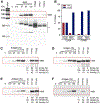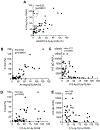Mechanism underlying severe deficiency of plasma ADAMTS-13 activity in immune thrombotic thrombocytopenic purpura
- PMID: 38360215
- PMCID: PMC11055658
- DOI: 10.1016/j.jtha.2024.02.003
Mechanism underlying severe deficiency of plasma ADAMTS-13 activity in immune thrombotic thrombocytopenic purpura
Abstract
Background: Immune-mediated thrombotic thrombocytopenic purpura is caused by autoantibodies against ADAMTS-13, a plasma enzyme that cleaves von Willebrand factor. However, the mechanism resulting in severe deficiency of plasma ADAMTS-13 activity remains controversial.
Objectives: To determine the mechanism of autoantibody-mediated severe deficiency of plasma ADAMTS13 activity in immune-mediated thrombotic thrombocytopenic purpura.
Methods: Fluorescence resonance energy transfer-VWF73 was used to determine plasma ADAMTS-13 activity. Enzyme-linked immunosorbent assay (ELISA) was used to determine anti-ADAMTS-13 immunoglobulin G. ELISA and capillary electrophoresis-based Western blotting were employed to assess plasma ADAMTS-13 antigen.
Results: We showed that plasma ADAMTS-13 antigen levels varied substantially in the samples collected on admission despite all showing plasma ADAMTS-13 activity of <10 IU/dL (or <10% of normal level) using either ELISA or Western blotting. More severe deficiency of plasma ADAMTS-13 antigen (<10%) was detected in admission samples by ELISA than by capillary Western blotting. There was a significant but moderate correlation between plasma ADAMTS-13 activity and ADAMTS-13 antigen by either assay method, suggesting that severe deficiency of plasma ADAMTS-13 activity is not entirely associated with low levels of ADAMTS-13 antigen.
Conclusion: We conclude that severe deficiency of plasma ADAMTS-13 activity primarily resulted from antibody-mediated inhibition, but the accelerated clearance of plasma ADAMTS-13 antigen via immune complexes may also contribute significantly to severe deficiency of plasma ADAMTS-13 activity in a subset of patients with acute immune-mediated thrombotic thrombocytopenic purpura.
Keywords: ADAMTS-13; TTP/HUS; autoantibodies; capillary Western blotting; von Willebrand factor.
Copyright © 2024 International Society on Thrombosis and Haemostasis. Published by Elsevier Inc. All rights reserved.
Conflict of interest statement
Declaration of competing interest X.L.Z. is a consultant for Alexion, Apollo, Sanofi, Takeda, Apollo, GC Biopharma, and Stago and a cofounder of Clotsolution.
Figures



Similar articles
-
Inhibitory autoantibodies against ADAMTS-13 in patients with thrombotic thrombocytopenic purpura bind ADAMTS-13 protease and may accelerate its clearance in vivo.J Thromb Haemost. 2006 Aug;4(8):1707-17. doi: 10.1111/j.1538-7836.2006.02025.x. J Thromb Haemost. 2006. PMID: 16879212 Free PMC article.
-
The clinical utility of ADAMTS13 activity, antigen and autoantibody assays in thrombotic thrombocytopenic purpura.Br J Haematol. 2007 Feb;136(4):649-55. doi: 10.1111/j.1365-2141.2006.06471.x. Br J Haematol. 2007. PMID: 17367414
-
Neutralization of inhibitory antibodies and restoration of therapeutic ADAMTS-13 activity levels in inhibitor-treated rats by the use of defined doses of recombinant ADAMTS-13.J Thromb Haemost. 2015 Nov;13(11):2053-62. doi: 10.1111/jth.13137. Epub 2015 Oct 12. J Thromb Haemost. 2015. PMID: 26340698
-
[Thrombotic Thrombocytopenic Purpura --Pathophysiology and Assays of ADAMTS13 Activity].Rinsho Byori. 2015 Oct;63(10):1228-36. Rinsho Byori. 2015. PMID: 26897861 Review. Japanese.
-
Von Willebrand factor, ADAMTS13, and thrombotic thrombocytopenic purpura.Blood. 2008 Jul 1;112(1):11-8. doi: 10.1182/blood-2008-02-078170. Blood. 2008. PMID: 18574040 Free PMC article. Review.
Cited by
-
Arginine Methylation by PRMT1 Affects ADAMTS13 Secretion and Enzymatic Activity.Arterioscler Thromb Vasc Biol. 2025 Apr;45(4):506-522. doi: 10.1161/ATVBAHA.124.322249. Epub 2025 Feb 13. Arterioscler Thromb Vasc Biol. 2025. PMID: 39945068
-
Mechanistic insight into multiple antibody binding to ADAMTS13 in immune thrombotic thrombocytopenic purpura.Res Pract Thromb Haemost. 2024 Oct 23;8(7):102603. doi: 10.1016/j.rpth.2024.102603. eCollection 2024 Oct. Res Pract Thromb Haemost. 2024. PMID: 39624585 Free PMC article.
-
A comparative study of anti-ADAMTS-13 antibody dynamics in immune-mediated thrombotic thrombocytopenic purpura.Res Pract Thromb Haemost. 2024 Jul 22;8(5):102525. doi: 10.1016/j.rpth.2024.102525. eCollection 2024 Jul. Res Pract Thromb Haemost. 2024. PMID: 39221447 Free PMC article.
References
-
- Luken BM, Kaijen PH, Turenhout EA, et al. Multiple B-cell clones producing antibodies directed to the spacer and disintegrin/thrombospondin type-1 repeat 1 (TSP1) of ADAMTS13 in a patient with acquired thrombotic thrombocytopenic purpura. J Thromb Haemost. 2006;4:2355–2364. - PubMed
Publication types
MeSH terms
Substances
Grants and funding
LinkOut - more resources
Full Text Sources

